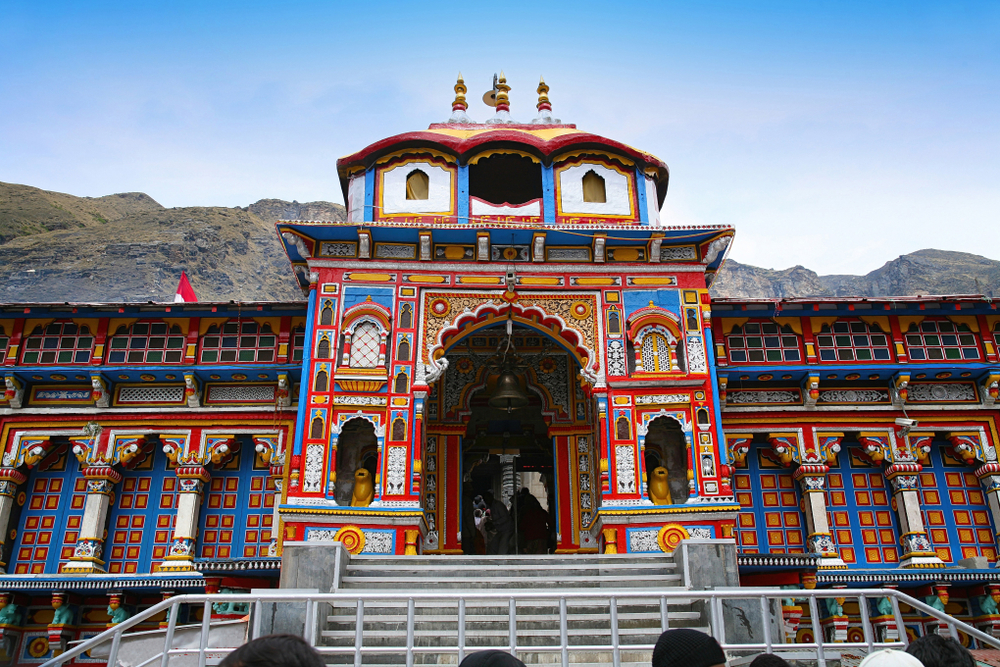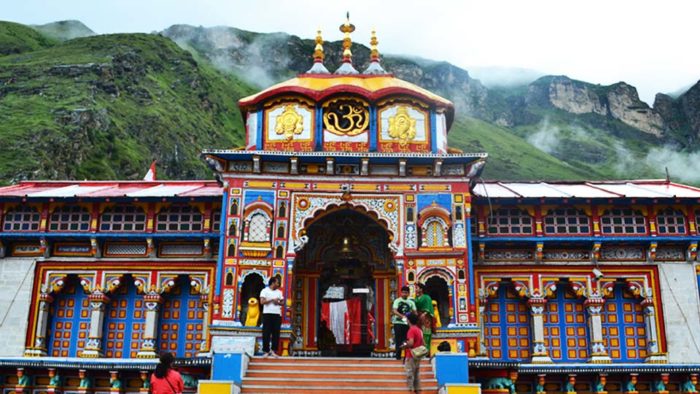Badrinath Yatra Tour Package 02 Night | 03 Days Ex. Haridwar
Book Now
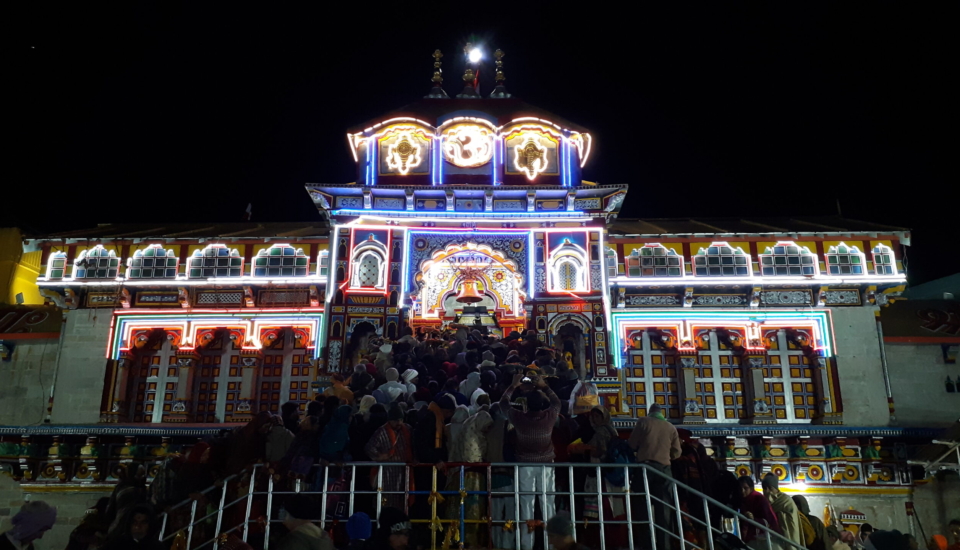

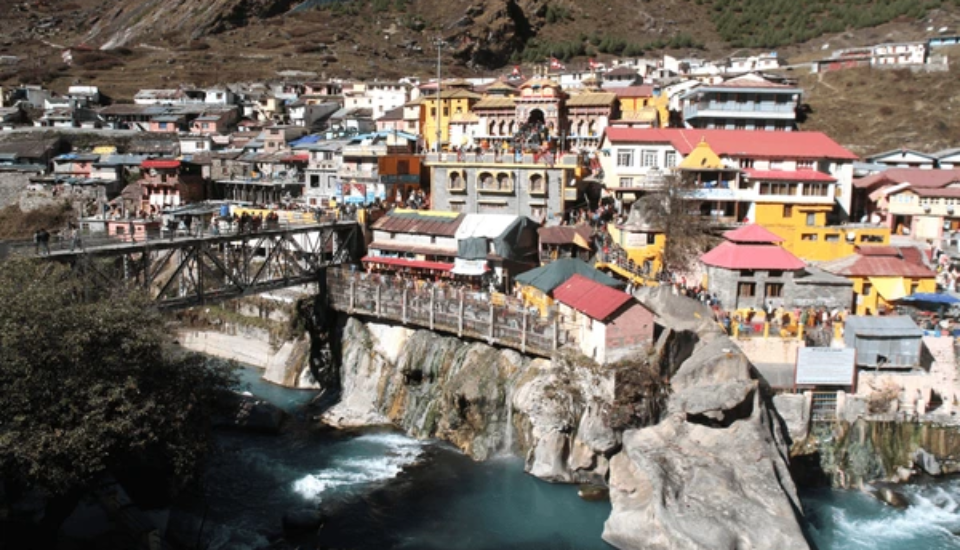
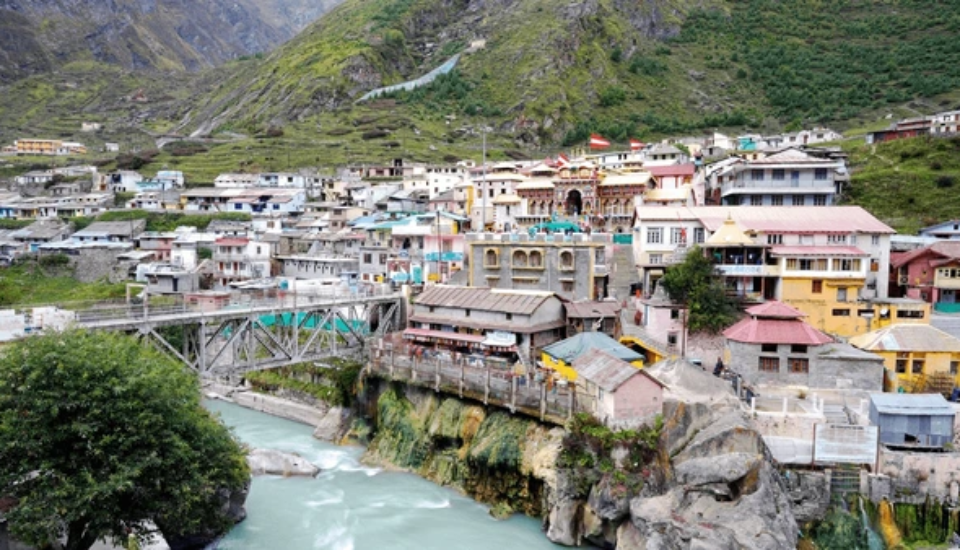
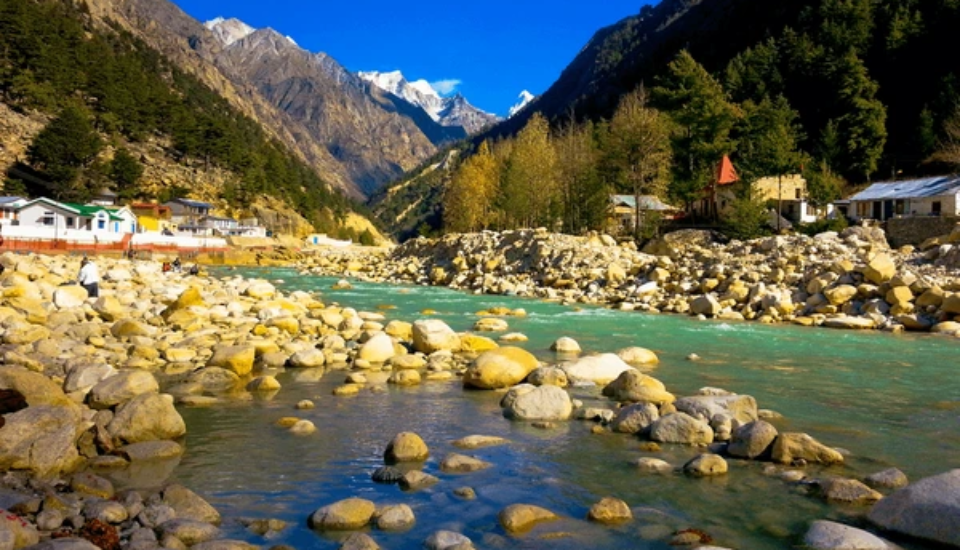
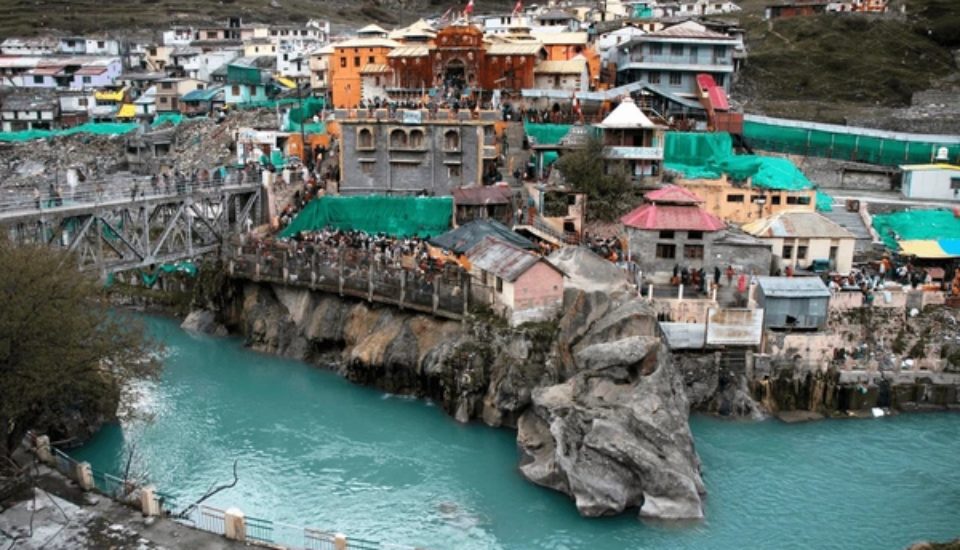
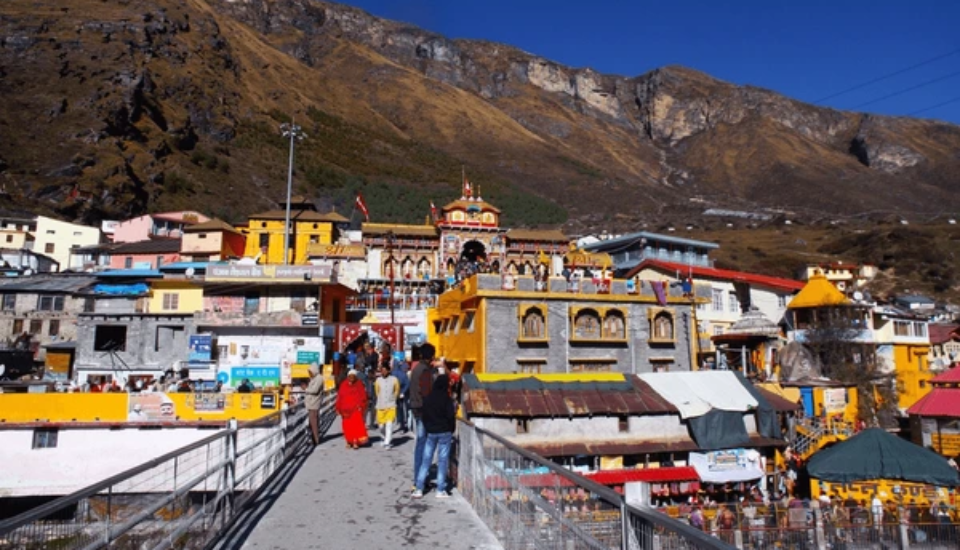
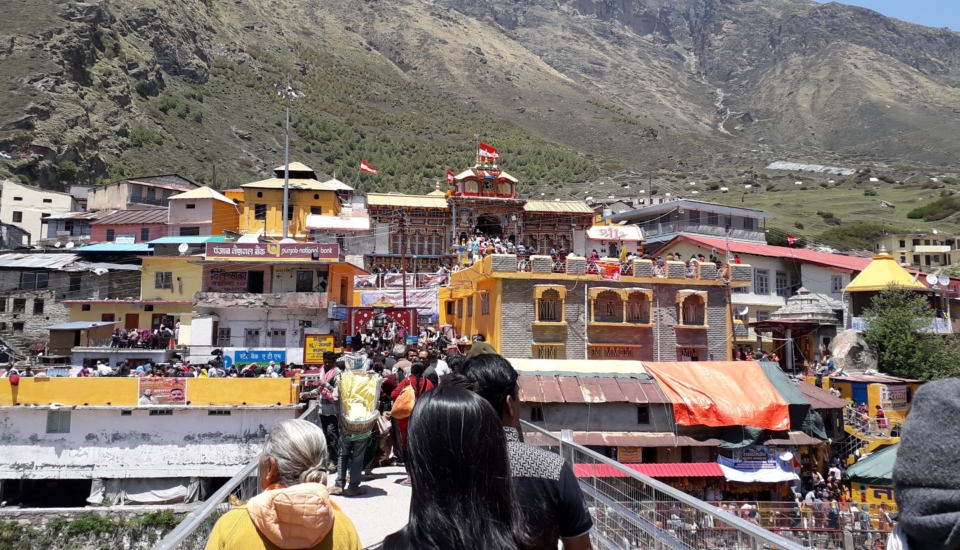

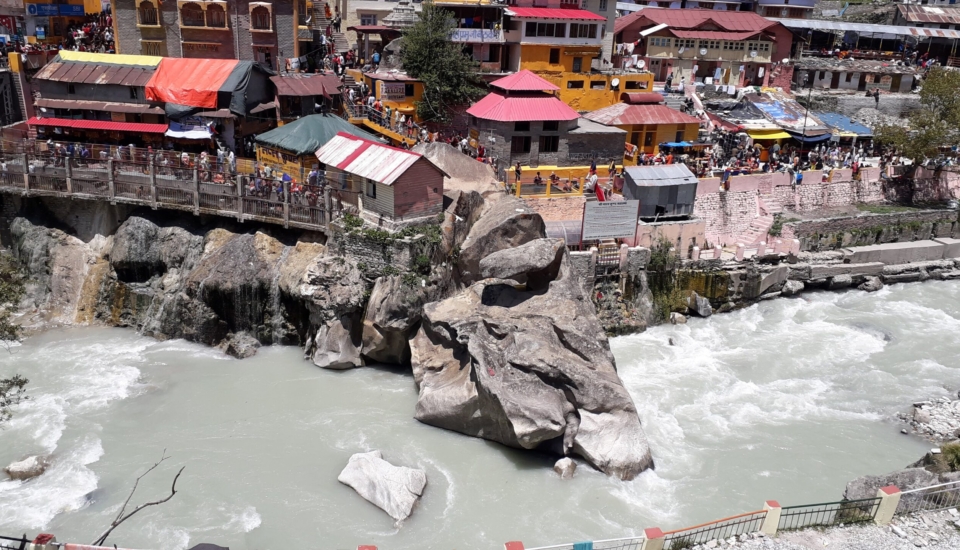
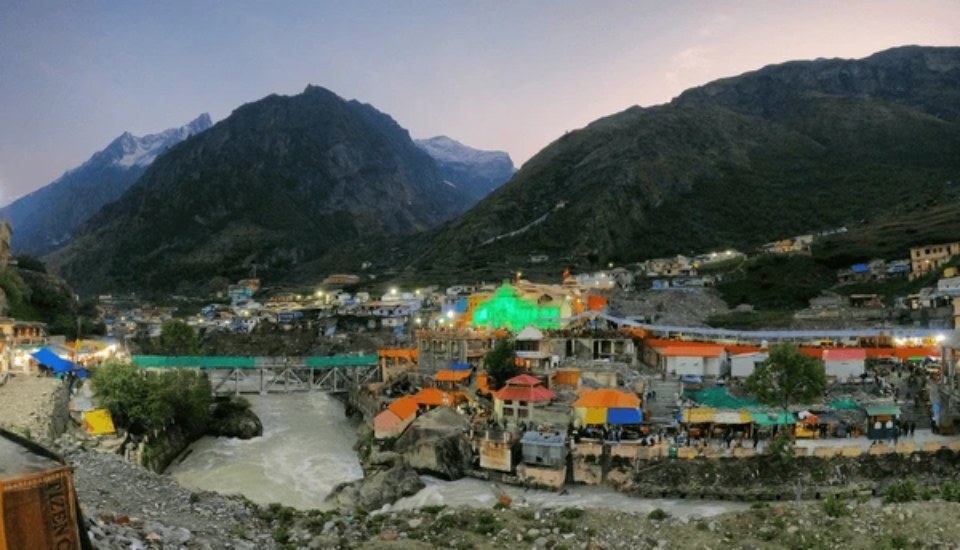

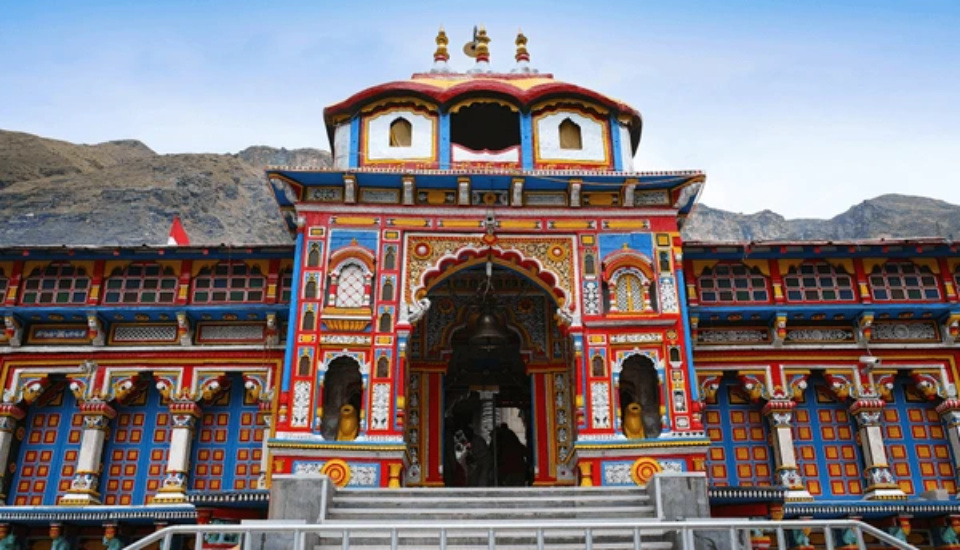
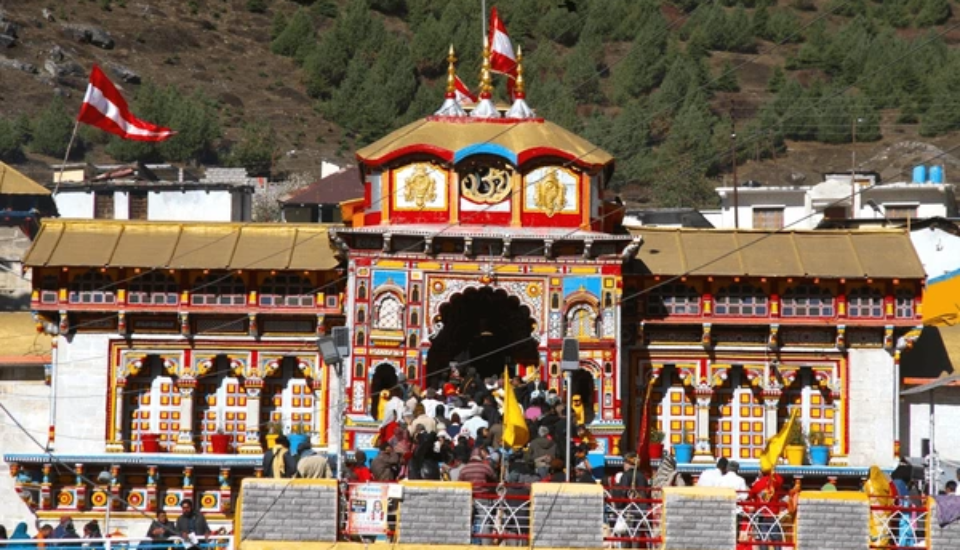
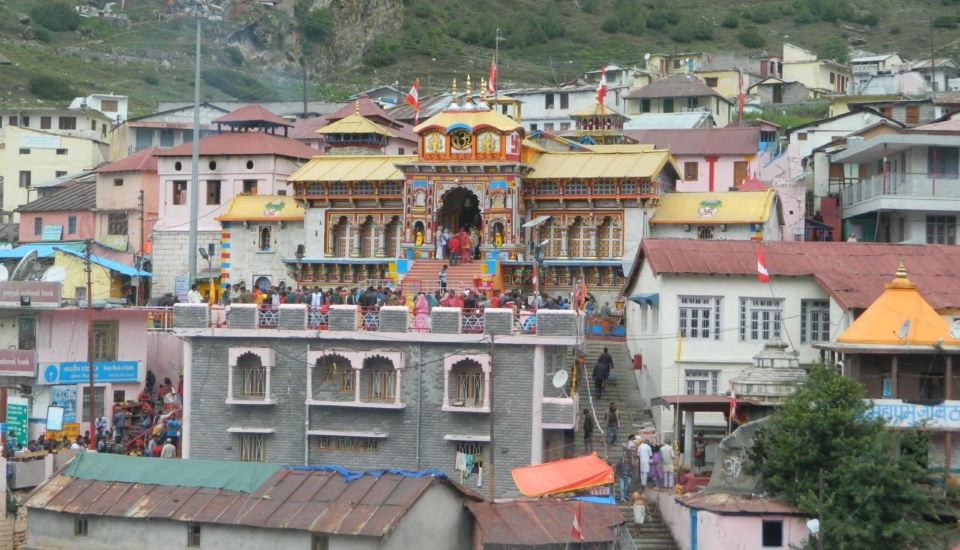

Nestled in the breathtaking lap of the Garhwal Himalayas in Uttarakhand, India, the sacred Badrinath Temple is one of Hindus’ most revered pilgrimage sites. Dedicated to Lord Vishnu, the temple stands at an altitude of approximately 3,133 meters (10,279 feet) above sea level, along the banks of the Alaknanda River. It is a vital part of the Chardham Yatra, which also includes Kedarnath, Gangotri, and Yamunotri, and is also one of the Panch Badri temples, making it a significant spiritual destination for devotees worldwide.
Badrinath Temple is an architectural marvel that reflects traditional North Indian temple design. The structure is built in a cone-shaped style, with a towering entrance and intricate carvings adorning its facade. The temple’s sanctum houses the revered black stone idol of Lord Vishnu, known as Badri Narayan, in a meditative pose. The idol is believed to be self-manifested (Swayambhu) and has been worshipped for centuries.
The temple complex also includes the Tapt Kund, a natural hot spring with medicinal properties, where devotees take a holy dip before entering the temple. Other important sites within the complex include the Narad Kund, Brahma Kapal, and Charan Paduka, each holding its spiritual significance.
Badrinath Temple is considered one of the most sacred shrines in Hinduism. It is an essential pilgrimage site for Vaishnavites (followers of Lord Vishnu) and a crucial part of the Chardham Yatra, which is believed to cleanse one’s soul and lead to spiritual liberation (Moksha). The temple opens every year in April or May and remains accessible until late October or early November, as heavy snowfall during winter makes the region impassable. Thousands of pilgrims visit Badrinath to seek blessings, meditate, and immerse themselves in the divine energy of this sacred land.
Badrinath Temple is not just a place of worship; it is a divine experience that transcends time and space. Surrounded by snow-capped peaks, lush valleys, and the holy Alaknanda River, the temple offers devotees and travellers an opportunity to reconnect with spirituality and find inner peace. Whether you visit for religious reasons, history, or to admire its breathtaking landscape, a journey to Badrinath Temple is truly a soul-enriching experience.
Badrinath finds its mention in several ancient Hindu scriptures, including the Mahabharata, Bhagavata Purana, and Skanda Purana. The mythology surrounding this temple is deeply intertwined with Lord Vishnu, sages, and celestial beings.
Badrinath, one of the most revered pilgrimage sites in India, is deeply rooted in Hindu mythology. While the temple is primarily associated with Lord Vishnu, the presence of Lord Shiva and Goddess Parvati in its legends adds to its spiritual significance. One of the most captivating stories linked to Badrinath is the tale of Shiva and Parvati’s connection to this sacred land.
According to ancient scriptures, Lord Shiva and Goddess Parvati once resided in the Badrinath region, enjoying its serene and divine surroundings. It is believed that this sacred land was their meditation ground, where they performed intense penance. The beauty of the place, with the Alaknanda River flowing gracefully and the towering Himalayas in the background, made it an ideal abode for the divine couple.
However, Lord Vishnu, in his Narayana form, desired to meditate in Badrinath. In order to establish the site as a Vishnu shrine, he disguised himself as a helpless child and started crying near the entrance of Shiva and Parvati’s dwelling. Hearing the cries of the child, Goddess Parvati, overwhelmed with compassion, picked him up and comforted him. She requested Lord Shiva to allow the child to stay in their sacred abode.
To Parvati’s surprise, the child refused to leave even after being consoled. Eventually, Lord Shiva realized that this was none other than Vishnu himself, who wished to claim Badrinath as his place of meditation. Understanding Vishnu’s divine intent, Lord Shiva and Goddess Parvati gracefully left the place and moved to Kedarnath, another sacred Himalayan shrine, which later became one of the most significant temples dedicated to Lord Shiva.
This mythological tale signifies the eternal balance between Vishnu and Shiva, two of the principal deities in Hinduism. It also reflects the spirit of selflessness and devotion, where even deities yield to each other for the greater good of the universe.
Today, while Badrinath is primarily a Vishnu temple, devotees also acknowledge the presence of Lord Shiva and Goddess Parvati in its sacred history. Pilgrims visiting Badrinath often extend their journey to Kedarnath, honouring both deities and seeking their divine blessings.
The story of Shiva and Parvati in Badrinath reminds us of the deep spiritual essence of this land, where gods once walked, meditated, and exemplified virtues of compassion, renunciation, and unity.
The sacred land of Badrinath is not just a revered pilgrimage site but also a place steeped in divine mythology. Among the many legends associated with this holy town, one of the most profound and cherished is the story of Lord Vishnu’s meditation.
According to Hindu mythology, Lord Vishnu, the preserver and protector of the universe, chose Badrinath as his meditation abode. It is said that he sought refuge in the cold and serene Himalayas to atone for the worldly pleasures he had indulged in. Immersed in deep penance, Lord Vishnu sat in profound meditation, completely detached from the harsh climate that surrounded him. The biting cold and freezing winds of the Himalayas did not disturb his focus as he remained steadfast in his divine pursuit.
Seeing her beloved consort in such an intense meditative state, Goddess Lakshmi was moved by her devotion to him. To protect Lord Vishnu from the freezing temperatures, she transformed herself into a Badri tree, offering him shelter and warmth. Her unwavering love and sacrifice touched Lord Vishnu deeply. As a mark of gratitude and reverence for her devotion, he named the place "Badrikashram," which later came to be known as Badrinath. The deity enshrined in the temple became renowned as Badrinath, symbolizing divine devotion, penance, and salvation.
The significance of this legend extends beyond mythology, as it conveys profound spiritual teachings. It highlights the ideals of devotion, selfless love, and the power of meditation in seeking divine wisdom and enlightenment. For countless devotees visiting Badrinath, this story serves as an inspiration, reminding them of the importance of dedication and perseverance in the pursuit of spiritual awakening.
Even today, Badrinath stands as a testament to this celestial event. The temple dedicated to Lord Badrinath attracts millions of pilgrims each year, all eager to witness and experience the sacred energy that continues to reside in this holy land. As devotees offer their prayers and pay homage, they are reminded of the eternal bond between Lord Vishnu and Goddess Lakshmi, a symbol of love, devotion, and the divine balance of the universe.
Thus, the legend of Lord Vishnu’s meditation remains one of the most revered and spiritually enriching tales in Hindu tradition. It continues to inspire generations, making Badrinath not just a pilgrimage site but a beacon of divine grace and enlightenment.
Badrinath, one of the holiest pilgrimage sites in India, is deeply rooted in Hindu mythology. Among its many divine legends, the story of the twin sages Nar and Narayan holds special significance. These two forms of Lord Vishnu are said to have meditated in the sacred land of Badrikashram (modern-day Badrinath) to establish the ideals of dharma (righteousness) and tapas (austerity).
Nar and Narayan were incarnations of Lord Vishnu, born as the twin sons of Dharma and Murti, the daughter of Daksha Prajapati. Their mission was to set an example of supreme penance and devotion to the Almighty. They chose the pristine and spiritually charged region of Badrikashram to engage in eternal meditation, spreading wisdom and righteousness across the world.
As the two divine sages immersed themselves in rigorous penance, their growing spiritual power became a subject of concern for Indra, the king of the heavens. Fearing that Nar and Narayan might surpass his celestial authority, Indra devised a plan to distract them. He sent apsaras (heavenly nymphs), along with Kamadeva (the god of desire), to break their meditation.
However, Nar and Narayan remained unshaken. In response, Narayan simply struck his thigh, and from it emerged an apsara named Urvashi, more beautiful than any celestial maiden sent by Indra. This act humbled Indra, as Narayan explained that material temptations held no power over those devoted to spiritual enlightenment. Defeated and enlightened, Indra retreated, acknowledging the supremacy of their penance.
Nar and Narayan continued their meditation in Badrikashram for thousands of years, ensuring the triumph of dharma over adharma (unrighteousness). It is believed that their divine presence still graces the holy land of Badrinath, making it a spiritually charged destination for pilgrims seeking salvation and enlightenment.
Moreover, in later mythology, Nar and Narayan reincarnated as Arjuna and Krishna in the Mahabharata, further reinforcing their divine role in protecting righteousness.
The tale of Nar and Narayan in Badrinath is not just a mythological story but a profound lesson on perseverance, devotion, and the eternal nature of dharma. Their legacy continues to inspire seekers on their spiritual journeys, making Badrinath an enduring symbol of divine enlightenment and divine presence.
Badrinath, one of the holiest pilgrimage sites in India, is not only known for its spiritual significance but also for its fascinating legends. Among the many mystical stories surrounding this sacred land, the tale of Nag and Nagin stands out—a story of love, devotion, and divine intervention.
The Love Story of Nag and Nagin
According to ancient folklore, a powerful serpent (Nag) and his beloved mate (Nagin) resided in the icy waters of the Alaknanda River, near Badrinath. The two celestial serpents were deeply in love and lived harmoniously in the pristine environment of the Himalayas. Their presence was believed to maintain the balance of nature, ensuring the purity of the holy waters and protecting the sacred land from negative forces.
One day, as fate would have it, a powerful sage arrived in Badrinath for meditation. His intense spiritual energy disturbed the divine couple’s peaceful existence. The Nag and Nagin, fearing their home would be disturbed, tried to plead with the sage to leave. However, the sage, lost in his meditation, did not heed their concerns.
Feeling helpless, the Nagin sought the blessings of Lord Vishnu, the presiding deity of Badrinath, to protect her home and beloved Nag. Moved by her devotion, Lord Vishnu appeared in his divine form and assured her that their legacy would never be forgotten. As a result, the Nag and Nagin took a celestial form and merged into the sacred waters of Badrinath, becoming eternal protectors of the land.
Symbolism and Spiritual Significance
Even today, it is believed that the presence of Nag and Nagin can be felt in the holy waters of Tapt Kund, the natural hot springs near the Badrinath temple. Pilgrims who take a dip in these sacred waters believe they are blessed by the divine serpent couple, ensuring protection from evil forces and granting them spiritual purification.
Many devotees also believe that the sight of a serpent near Badrinath is a sign of good fortune, symbolizing the eternal bond of love and devotion between Nag and Nagin.
The story of Nag and Nagin serves as a timeless reminder of divine love, the power of devotion, and the protective energy that surrounds the sacred land of Badrinath.
Narada Muni, a divine sage and an ardent devotee of Lord Vishnu, played a crucial role in spreading devotion and wisdom. Despite being a celestial being, Narada sought to understand the depth of true devotion and embarked on a spiritual journey.
One of the most intriguing legends surrounding Narada Muni took place in Badrinath. As the story goes, Narada was deeply devoted to Lord Vishnu, but he once expressed pride in his unwavering bhakti (devotion). Lord Vishnu, understanding that true devotion is beyond ego, decided to teach Narada a lesson in humility.
To test him, Lord Vishnu created an illusion where Narada found himself reincarnated as a king. As a ruler, Narada became engrossed in worldly affairs, forgetting his devotion to Vishnu. However, as time passed, he faced trials and tribulations that ultimately reminded him of the Lord. Realizing his mistake, Narada prayed earnestly, and Lord Vishnu appeared, restoring him to his original form. Humbled, Narada truly understood that devotion is not just about singing praises but about surrendering one’s ego and remaining steadfast in faith.
This profound story, often associated with Badrinath, highlights the essence of bhakti—unwavering love and surrender to the divine. Even today, devotees visiting Badrinath seek to emulate Narada’s realization, striving for pure devotion without pride or ego.
Badrinath Ji remains an eternal symbol of spiritual awakening, drawing seekers from across the world to experience its divine aura and timeless legends.
The Mahabharata narrates that after the great Kurukshetra war, the Pandavas ruled the kingdom for several years. However, realizing that their time on earth was ending, they decided to renounce their kingdom and embark on their final journey to attain moksha (liberation). This journey took them through several sacred places, including Badrinath and ultimately to Swargarohini, the ‘stairway to heaven.’
The name ‘Neelkanth’ means ‘Blue Throat,’ a direct reference to Lord Shiva, one of the most venerated deities in Hinduism. According to legend, during the great churning of the cosmic ocean (Samudra Manthan), a deadly poison, Halahala, emerged that threatened to destroy the universe. To save creation, Lord Shiva consumed the poison, which turned his throat blue, earning him the title 'Neelkanth.' This divine act of sacrifice symbolizes Shiva’s role as the protector andsaviourr of the cosmos.
Devotees believe that Neelkanth Mountain is a manifestation of Lord Shiva himself, standing as a guardian over the sacred temple town of Badrinath. The towering presence of the peak serves as a constant reminder of Shiva’s boundless compassion and strength.
The peak stands as a divine guardian over Badrinath, symbolizing the omnipresence of Lord Shiva alongside Lord Vishnu.
According to Hindu mythology, the descent of the Ganga from the heavens to Earth was a celestial event that shaped the course of many tributaries, including the Alaknanda.
The legend of Ganga’s descent is rooted in the devotion of King Bhagirath. Determined to liberate the souls of his ancestors, who had been cursed and turned to ashes, Bhagirath performed severe penance to invoke the celestial river, Ganga. Pleased with his devotion, Lord Brahma granted his request, but the mighty force of the Ganga’s descent threatened to shatter the Earth. To prevent this catastrophe, Lord Shiva caught the river in his matted locks, softening its impact and allowing its waters to flow gently in different streams. Among these divine tributaries was the Alaknanda, which sanctified the land of Badrinath.
The Alaknanda River originates from the confluence of the Satopanth and Bhagirath Kharak glaciers near Badrinath in Uttarakhand. Its waters are considered sacred, and pilgrims believe that a dip in the Alaknanda purifies the soul and washes away sins. Flowing through rugged Himalayan terrain, the river joins the Bhagirathi River at Devprayag, where their confluence marks the official formation of the Ganges.
Apart from the main Badrinath Temple, the region is home to six other temples dedicated to Lord Vishnu, collectively known as Sapt Badri:
This is the principal Badri temple and the most significant among the seven. It is where Lord Vishnu is worshipped in his Badri Narayan form.
Located 17 km from Karnaprayag, Adi Badri is considered the oldest Vishnu temple in the region. It is believed that Lord Vishnu was worshipped here before the Badrinath Temple was established.
Situated at Animath, this temple remains open throughout the year. According to legend, Lord Vishnu appeared here in an old (Vridha) form before manifesting as Badri Narayan at Badrinath.
This temple is located near Tapovan and is believed to be the future abode of Lord Vishnu. It is prophesied that when the current Badrinath temple becomes inaccessible, Bhavishya Badri will become the next major pilgrimage site.
Situated at Pandukeshwar, Yogdhyan Badri is associated with King Pandu, the father of the Pandavas. It is said that King Pandu meditated here and attained salvation.
Located in the Urgam Valley, Dhyan Badri derives its name from the term ‘Dhyan’ (meditation). The temple enshrines a four-armed idol of Lord Vishnu in a meditative posture.
Among the lesser-known Badri temples, Ardha Badri is unique as the idol of Lord Vishnu here is smaller compared to other temples.
The present-day Badrinath Temple owes its existence to the great philosopher and saint Adi Shankaracharya. In the 8th century CE, he rediscovered the idol of Lord Vishnu from the Alaknanda River and enshrined it in a cave near Tapt Kund, a hot water spring. Later, the temple structure was built to house the deity and became a major center of Hindu devotion.
Over centuries, several kings and devotees contributed to the temple’s renovation. The Garhwal Kings played a significant role in its upkeep, ensuring that it remained a revered pilgrimage site. In modern times, the temple has been maintained by the Badrinath-Kedarnath Temple Committee.
The temple’s architecture is an exquisite example of traditional Garhwali design, featuring a conical-shaped roof, intricate carvings, and a vibrant entrance. The main deity, a 1-meter tall black stone idol of Lord Vishnu in a meditative pose, is said to be Swayambhu (self-manifested).
Badrinath Dham, nestled in the majestic Garhwal Himalayas of Uttarakhand, India, is a revered pilgrimage site. Situated at an altitude of 3,133 meters (10,279 feet) above sea level, it rests on the banks of the Alaknanda River. The town is surrounded by breathtaking snow-capped peaks, with the towering Neelkanth Peak providing a stunning backdrop. The rugged terrain and scenic landscapes make it a spiritually enriching and visually mesmerizing destination.
Summer is the best time to visit Badrinath, with pleasant temperatures ranging from 7°C to 18°C. The weather is ideal for darshan and sightseeing, offering clear skies and a refreshing mountain breeze.
The region receives heavy rainfall, leading to landslides and slippery roads. While the temple remains open, travellers should be cautious while planning their journey. Carrying rain gear and checking weather updates is advisable.
As winter approaches, temperatures drop to 0°C or lower. However, this period is less crowded, offering a peaceful pilgrimage experience before the temple closes for the season.
The temple remains closed due to heavy snowfall and freezing temperatures, often dropping below -10°C. During this time, the deity is shifted to Joshimath for worship.
For a comfortable visit, plan your trip between May and June or September to early November for a spiritually fulfilling and scenic journey.
Badrinath is a small town with a limited permanent population, primarily priests, temple workers, and seasonal business owners. During the pilgrimage season, thousands of devotees from across India and the world visit, significantly boosting the town’s temporary population. The local culture is deeply rooted in Hindu traditions and hospitality.
How to Reach Badrinath: Your Complete Travel Guide
Badrinath, one of the holiest pilgrimage destinations in India, is nestled in the Garhwal Himalayas of Uttarakhand. Dedicated to Lord Vishnu, it is part of the Chardham Yatra and holds immense spiritual significance. Whether you’re travelling by air, rail, or road, here’s how you can reach this divine destination with ease.
The nearest airport to Badrinath is Jolly Grant Airport in Dehradun, which is approximately 310 km away. From Dehradun, you can hire a taxi or take a bus to reach Badrinath. Helicopter services are also available from Dehradun and Phata for a quicker and more comfortable journey.
The nearest railway station is Rishikesh Railway Station, about 295 km from Badrinath. Rishikesh is well-connected to major cities like Delhi, Haridwar, and Dehradun. From Rishikesh, you can take a bus, private taxi, or shared cab to reach your destination.
Badrinath is accessible by well-maintained roads and is connected to major cities via NH-58. Here are some common road routes:
Regular buses and taxis are available from Rishikesh, Haridwar, and Dehradun for Badrinath. You can also opt for private cabs or self-drive options.
For a smooth and hassle-free journey, it’s essential to understand the route map. Here’s a breakdown of the travel path:
Badrinath, one of the holiest pilgrimage sites in India, is a sacred destination for devotees seeking spiritual blessings. Nestled in the Himalayas, the Badrinath temple is dedicated to Lord Vishnu and offers various pujas to fulfil different religious and personal aspirations. Here is a detailed list of 20 pujas available at Badrinath Temple along with their approximate prices:
Chanting of the 1000 names of Lord Vishnu for spiritual purification and well-being.
₹2,100
A holy bath ritual is performed with sacred waters, milk, honey, and ghee.
₹4,000
A grand ritual for seeking divine blessings and prosperity.
₹11,000
A powerful puja dedicated to Lord Shiva for removing negative energies.
₹6,500
Experience the divine morning and evening aarti ceremonies.
₹1,000
A special aarti was performed with golden lamps for Lord Vishnu.
₹4,000
An aarti performed using camphor to invoke the deity’s blessings.
₹2,500
A dedicated puja for invoking Lord Vishnu’s divine presence.
₹5,100
A ritual to appease the nine planets and reduce astrological doshas.
₹7,500
A sacred recitation that brings happiness and prosperity.
₹5,500
Offering Tulsi leaves to Lord Vishnu for divine blessings.
₹3,100
A ritual for honouring ancestors and ensuring their peace in the afterlife.
₹5,000
A sacred offering for the departed souls.
₹6,000
A special ritual for ancestral salvation.
₹10,000
A puja for wealth, prosperity, and family well-being.
₹7,000
Chanting of 1,000 names of Lord Krishna.
₹3,500
A powerful havan for protection and divine grace.
₹8,000
Offering sacred food to the deity before distribution to devotees.
₹2,200
A special observance and storytelling for spiritual upliftment.
₹4,500
A daily puja for seeking divine guidance and well-being.
₹5,200
Prices may vary depending on the temple administration and season. Devotees are advised to confirm puja bookings in advance.
Book your puja at Badrinath and experience divine blessings for you and your family!
Badrinath, one of the holiest pilgrimage sites in India, is not just a spiritual destination but also a place of grand celebrations. Throughout the year, the temple hosts several festivals that are deeply rooted in Hindu traditions, attracting thousands of devotees. Here are ten significant festivals celebrated in Badrinath and their timings:
This festival honours Mata Murti, the mother of Lord Narayan. Devotees believe she brought the holy Alaknanda River to earth. Celebrated in September, this festival features special prayers and rituals at the Mata Murti Temple, located near Badrinath.
This is a grand cultural festival that takes place between Badrinath and Kedarnath temples. It includes devotional music, dance performances, and religious gatherings, celebrating the connection between Lord Vishnu (Badrinath) and Lord Shiva (Kedarnath).
The temple opens for pilgrims in late April or early May, depending on the Akshaya Tritiya date. A grand ceremony, including Vedic rituals and chanting, marks the reopening of the temple after months of closure during winter.
The birth of Lord Krishna, an incarnation of Vishnu, is celebrated with great devotion at Badrinath. The temple hosts special pujas, bhajans, and recitations from the Bhagavad Gita on this auspicious night.
Diwali marks the ceremonial closing of the temple for winter. The idol of Lord Badrinath is bathed in sesame oil, and grand aartis are performed before the doors are sealed for six months.
This festival celebrates the descent of the Ganges from heaven to earth. Although mainly associated with the River Ganges, special pujas are held at Badrinath, where the Alaknanda River is worshipped.
This festival, dedicated to Lord Vishnu, includes night-long prayers and lighting of lamps at the temple, symbolizing the divine presence.
When the temple opens and closes, a ceremonial procession carries Lord Badrinath’s idol from Pandukeshwar to the temple and back, marking the beginning and end of the pilgrimage season.
Badrinath, one of the most sacred pilgrimage sites in India, welcomes thousands of devotees every year. Whether you’re a solo traveller, a family on a spiritual journey, or part of a larger pilgrimage group, finding the right accommodation is essential for a comfortable stay.
Badrinath offers a range of accommodations, from budget-friendly Dharamshalas and guesthouses to comfortable mid-range hotels and premium lodges. Many guesthouses and ashrams provide basic yet clean facilities at affordable rates, making them ideal for devotees looking for a simple stay. Hotels and lodges in Badrinath cater to travellers seeking extra comfort, offering cosy rooms with attached bathrooms, hot water facilities, and in some cases, Wi-Fi and in-house dining.
For those seeking an authentic spiritual experience, several ashrams in Badrinath offer accommodations with vegetarian meals and meditation sessions. Additionally, government-run GMVN (Garhwal Mandal Vikas Nigam) lodges provide reliable lodging options with decent amenities at reasonable prices. Since Badrinath is a seasonal destination (open from April/May to October/November), it’s advisable to book accommodations in advance, especially during peak pilgrimage months.
After a long journey to this sacred destination, nourishing and wholesome food is a must. Badrinath offers a variety of vegetarian food options that align with the religious significance of the town.
Most eateries in Badrinath serve North Indian and Garhwali cuisine, with popular dishes like Aloo Puri, Rajma Chawal, and Khichdi being staple meals. Since it is a pilgrimage site, only pure vegetarian food (without onion and garlic) is served in most places. You’ll find many dhabas and restaurants near the temple offering thali meals that include dal, rice, sabzi, and roti, providing a fulfilling and sattvic dining experience.
For those craving South Indian flavours, a few restaurants serve dishes like dosa, idli, and upma. Chai (tea) stalls are scattered around, offering warm relief in the cold weather. If you prefer home-cooked meals, some guesthouses and Dharamshalas provide simple food options for their guests.
It’s important to note that due to the high altitude, food availability may be limited late at night. Therefore, it’s always a good idea to have your meals early. Carrying dry snacks, energy bars, or packaged food is also recommended while travelling.
Badrinath ensures that every pilgrim is well taken care of, offering both comfortable stays and fulfilling meals for a peaceful and spiritual experience.
Excursions & Attractions in Badrinath – Must-Visit Places
Badrinath, nestled in the breathtaking Garhwal Himalayas of Uttarakhand, is not just a revered pilgrimage site but also a paradise for nature lovers and adventure seekers. Whether you are visiting for spiritual bliss or to soak in the beauty of the majestic landscapes, Badrinath has plenty to offer. Here are some must-visit attractions and excursions around Badrinath:
The centrepiece of the town, the Badrinath Temple, is one of the holiest shrines dedicated to Lord Vishnu. The temple, with its striking architecture and rich history, attracts thousands of devotees every year. Nestled between the Nar and Narayan mountain ranges, it is open from April/May to November, depending on weather conditions. The aura of the temple, combined with the chants of Vedic hymns, offers a deeply spiritual experience.
Located near the temple, Tapt Kund is a natural hot water spring believed to have medicinal properties. Pilgrims take a holy dip in its waters before offering prayers at the Badrinath Temple. The temperature of the spring remains around 45°C, even in freezing winters. It is said that taking a dip in the Kund purifies the soul and relieves ailments.
Just 3 km from Badrinath lies Mana Village, the last inhabited village near the Indo-Tibetan border. It is a picturesque hamlet with traditional houses, local handicrafts, and stories from Hindu mythology. Don’t miss the famous Bheem Pul, a natural stone bridge believed to have been placed by Bheem from the Mahabharata. The village is also home to Vyas Gufa, where Sage Vyas is believed to have composed the Mahabharata.
Nag-Nagin Mandir in Badrinath is a sacred temple dedicated to serpent deities. Nestled near the holy town, it holds deep spiritual significance for devotees. Pilgrims visit to seek blessings and protection from serpent gods. Surrounded by serene beauty, it offers a peaceful retreat for prayers and meditation.
A short trek of around 6 km from Mana Village takes you to the stunning Vasudhara Falls, cascading from a height of 400 feet. Surrounded by snow-clad peaks, the waterfall is believed to bless only the pure-hearted visitors with its holy waters. The trek itself is a rewarding experience, offering scenic beauty and tranquillity.
A sacred rock formation located about 3 km from Badrinath, Charan Paduka is believed to bear the footprints of Lord Vishnu. The short yet steep trek to this spot offers mesmerizing views of the valley below. Devotees visit this place seeking blessings and spiritual elevation.
Towering at an altitude of 6,597 meters, Neelkanth Peak, also called the ‘Queen of Garhwal,’ is a sight to behold. It forms a stunning backdrop to the Badrinath Temple, especially during sunrise when its peak glows golden. The adventurous souls can opt for trekking expeditions to enjoy the breathtaking scenery up close.
A significant site on the banks of the Alaknanda River, Brahma Kapal is where devotees perform rituals for their ancestors. The peaceful atmosphere and the sound of flowing water make it a deeply spiritual experience. It is believed that performing these rites here grants salvation to the departed souls.
Close to Mana Village, the Saraswati River emerges from a rock and flows for a short distance before merging with the Alaknanda. This rare sight is of great significance in Hindu mythology. The roaring river, gushing through narrow passages, adds to the mysticism of the place.
Located near the Saraswati River, Alka Puri Glacier is believed to be the source of the Alaknanda River. The glacier is surrounded by majestic peaks and offers an awe-inspiring view. Trekking enthusiasts can explore this region for a thrilling experience.
About 22 km from Badrinath, Satopanth Lake is a high-altitude glacial lake known for its crystal-clear waters and serene surroundings. According to legend, the Trimurti (Brahma, Vishnu, and Shiva) meditated on the banks of this lake. The challenging trek to Satopanth is rewarded with panoramic views of the snow-capped peaks.
Situated close to Tapt Kund, Narad Kund is another thermal spring where it is believed that Adi Shankaracharya found the idol of Lord Badrinath. Pilgrims visit this holy spot to seek divine blessings.
Located around 25 km from Badrinath, Pandukeshwar is an ancient village associated with the Pandavas. It is home to two important temples, Yogadhyan Badri and Vasudev Temple, which are significant in Hindu mythology. The village is an ideal stop for those interested in history and spirituality.
About 45 km from Badrinath, Joshimath is an important spiritual and adventure hub. It is the winter seat of Lord Badri and houses the sacred Narsingh Temple. Joshimath also serves as a gateway to the Valley of Flowers, Auli, and Hemkund Sahib. The ropeway to Auli from Joshimath offers breathtaking views of the Himalayas.
A UNESCO World Heritage Site, the Valley of Flowers is a paradise for nature lovers. Located a short distance from Badrinath, the valley is covered with a vibrant carpet of wildflowers during the monsoon season. Trekkers and photographers find this place a dreamland of colours and serenity.
One of the most revered Sikh pilgrimage sites, Hemkund Sahib is a scenic Gurudwara situated at an altitude of 4,632 meters. The trek to Hemkund Sahib is challenging but rewarding, with mesmerizing landscapes and a glacial lake reflecting the surrounding snow-clad peaks.
Badrinath is a land of divine beauty, spirituality, and adventure. Whether you’re a pilgrim or a traveller, the town and its surroundings will leave you spellbound with their mystical charm! From spiritual retreats to breathtaking landscapes, Badrinath offers an experience like no other.
Badrinath, a sacred town in Uttarakhand, India, is one of the holiest pilgrimage sites for Hindus. Nestled in the Himalayas at an altitude of 3,133 meters, it holds immense spiritual and historical significance. Here are 10 interesting facts about Badrinath that make it a must-visit destination.
1. One of the Char Dham
Badrinath is part of the Char Dham Yatra, which includes Kedarnath, Gangotri, and Yamunotri. It is also a key site in the larger Char Dham pilgrimage (Badrinath, Dwarka, Puri, Rameswaram).
2. Dedicated to Lord Vishnu
The Badrinath Temple is dedicated to Lord Vishnu, worshipped here in the form of Badrinarayan. According to legend, Lord Vishnu meditated here while Goddess Lakshmi provided shade in the form of a Badri tree.
3. Mythological Significance
It is believed that Adi Shankaracharya discovered the idol of Lord Vishnu in the Alaknanda River and installed it in the temple, reviving Hindu worship at the site.
4. Accessible Only for Half the Year
Due to extreme weather conditions, the temple remains open only from April/May to November. During winter, the idol is moved to Joshimath for worship.
5. Alaknanda River Flows Beside It
Badrinath is located along the Alaknanda River, which originates from the Satopanth Glacier.
6. Hot Springs – Tapt Kund
Pilgrims take a dip in the Tapt Kund, a natural hot water spring, before entering the temple.
7. Home to Mana Village
Just a few kilometres away is Mana, the last Indian village before the Tibet border.
8. Associated with the Pandavas
It is believed that the Pandavas passed through Badrinath on their way to heaven.
9. Neelkanth Peak
The majestic Neelkanth Peak provides a stunning backdrop to the temple.
10. Visited by Millions
Every year, millions of devotees and tourists visit Badrinath, seeking blessings and experiencing its serene beauty.
Planning a trip to Badrinath? This sacred destination, nestled in the Himalayas, offers breathtaking landscapes and spiritual bliss. To ensure a smooth journey, follow these 10 essential travel tips.
1. Check the Best Travel Season
The temple is open from May to November. The ideal time to visit is between May and June or September to October, avoiding heavy monsoon rains.
2. Acclimate to High Altitude
Badrinath is at 3,133 meters. To prevent altitude sickness, take a day to acclimatize in lower-altitude towns like Joshimath before heading up.
3. Dress in Warm Layers
Even in summer, temperatures can drop significantly. Carry woollens, thermals, gloves, and a windproof jacket.
4. Book Accommodation in Advance
Hotels and lodges fill up quickly during peak season. Secure your stay in Joshimath or Badrinath well in advance.
5. Travel in a Sturdy Vehicle
The roads are steep and winding. Hiring an experienced driver and a well-maintained vehicle is highly recommended.
6. Keep Emergency Contacts Handy
Save numbers of local hospitals, police, and travel helplines. Also, carry a basic medical kit.
7. Carry Cash
ATMs are scarce and may not always function. Carry sufficient cash for food, lodging, and donations.
8. Follow Temple Guidelines
Wear modest attire, remove footwear before entering, and respect the sanctity of the temple premises.
9. Stay Hydrated & Eat Light
High altitudes can cause dehydration. Drink plenty of water and consume light, vegetarian meals to avoid discomfort.
10. Explore Nearby Attractions
Don’t miss Mana Village, Vasudhara Falls, and Tapt Kund for a complete spiritual and scenic experience.
By following these tips, your journey to Badrinath will be smooth, safe, and spiritually enriching.

